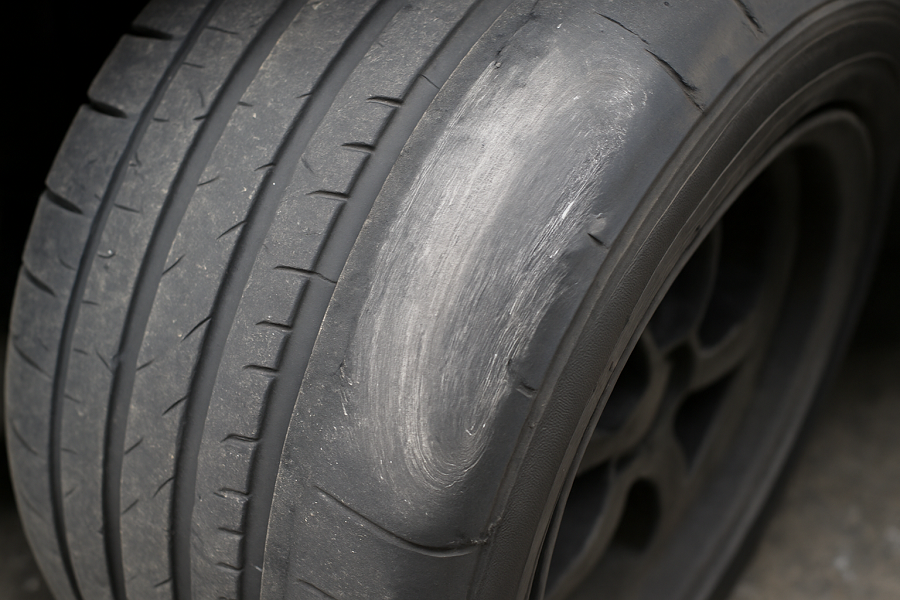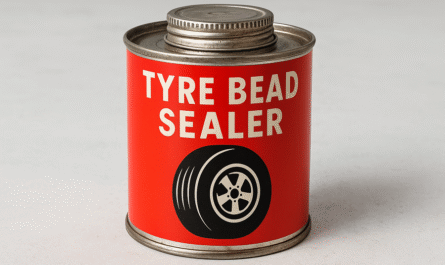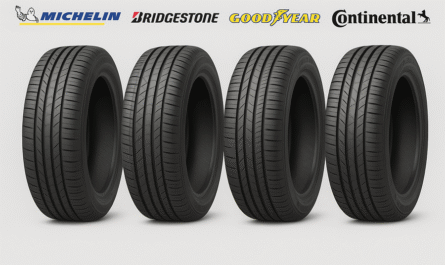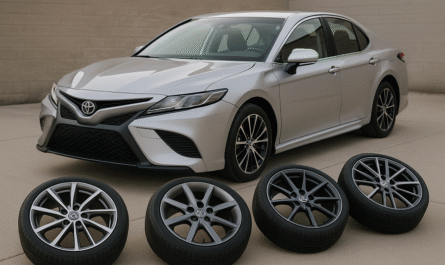Table of Contents
Table of Contents
When you notice your car’s tires wearing down unevenly, particularly on the inner edges, it’s a sign that something’s off with your car. Wear on Inside of Tyre refers to excessive or uneven tire tread loss on the inner side of the tire, the part nearest to the vehicle’s centerline. This isn’t just a cosmetic issue; it’s a sign that your car’s alignment, suspension, or tire maintenance requires attention. For the average car owner, spotting and addressing Wear on Inside of Tyre early can save cash, enhance safety, and boost tire life.
Think of your tires as the shoes of your car. Just as worn-out soles on one side of your shoes can throw off your stride, uneven tire wear can affect how your car handles, brakes, and stays safe on the road. In this manual, we’ll break down the Inner tire wear symptoms, causes, dangers, and solutions for Wear on Inside of Tyre in a way that’s easy to grasp, even if you’re not a car expert. Let’s dive in.
Common Causes of Wear on Inside of Tyre
Wear on Inside of Tyre doesn’t happen randomly. Several underlying problems can cause your tires to wear faster on the inside than elsewhere. Understanding these reasons is the first step to fixing the problem.
Wheel Misalignment
Wheel alignment refers to how your tires are angled relative to the road and each other. If the alignment is off, your tires may not sit flat on the road, causing uneven wear. Two key alignment angles often contribute to Wear on Inside of Tyre:
- Camber: This is the tilt of the tire, either inward or outward, when viewed from the front of the car. Too much negative camber (tilting inward at the top) causes the inner edge of the tire to carry more weight, wearing it down faster. Imagine leaning too much on one side of your shoe; it wears out faster on that side.
- Toe: This describes whether the tires point slightly inward (toe-in) or outward (toe-out) when viewed from above. False toe settings can scrub the inner edges of tires, especially if the toe is too far in or out.
Worn Suspension Components
Your car’s suspension system, think shocks, struts, bushings, and control arms, keeps your tires in proper contact with the road. Worn or damaged suspension parts, like a sagging spring or a loose ball joint, can throw off alignment angles, leading to Wear on Inside of Tyre. For example, a worn control arm bushing is like a wobbly table leg; it destabilizes everything, forcing the tire to wear unevenly.
Incorrect Tire Pressure
Tires need the right air pressure to distribute the car’s weight evenly across the tread. Underinflation or overinflation can cause irregular tire wear. Low pressure, in particular, causes the tire to sag, putting additional stress on the inner edges. Check your car’s suggested tire pressure (usually on a sticker inside the driver’s door or in the owner’s manual) to bypass this.
Driving Habits and Road Conditions
Aggressive driving, like sharp cornering or speeding over potholes, can accelerate inner tire wear. Rugged roads or frequent driving on uneven surfaces can also stress suspension components, indirectly causing wear. For instance, hitting a curb might not just dent your rim; it can knock your alignment out of whack.
Manufacturing or Installation Issues
In rare cases, a tire itself might be defective, or improper installation (like uneven tightening of lug nuts) can cause uneven wear. Always ensure tires are mounted by a professional to avoid these issues.
Inner Tire Wear Symptoms
Spotting Wear on Inside of Tyre earlier can save you from expensive repairs or unsafe driving situations. Here’s how to determine the problem through visible signs and changes in how your car feels on the road.
Visible Signs of Wear on Inside of Tyre
- Uneven Tread Wear: Run your hand along the inner edge of the tire. If it feels smoother or more worn than the outer edge, you’ve got inner tire wear. You might also see bald spots or exposed tire cords in severe cases.
- Feathering or Scalloping: The tread might feel jagged or “feathered” when you rub it one way but smooth the other. This often points to alignment issues.
- Tire Sidewall Damage: Wear on Inside of Tyre can sometimes come with sidewall scuffs or cuts if the tire is rubbing against suspension parts.
Changes in Driving Behavior
- Pulling to One Side: If your car drifts left or right without steering input, it could indicate misalignment causing Wear on Inside of Tyre.
- Vibration or Wobbly Steering: Worn suspension parts or uneven tire wear can make the steering wheel shake, especially at higher speeds.
- Noisy Tires: A humming or thumping sound from the tires, particularly when turning, can signal uneven wear.
- Poor Handling: If your car feels less responsive or “sloppy” during turns, Wear on Inside of Tyre might be reducing traction.
How to Check
To confirm Wear on Inside of Tyre, park on a flat surface and check each tire. Use a tread depth gauge (available for under $10 at auto stores) to calculate the tread depth on the inner, middle, and outer edges. A notable difference (e.g., 2–3 mm less on the inner edge) is a red flag. Also, jack up the car (safely!) to check for play in the wheel, which could indicate suspension issues.
Inner Tire Wear Dangerous
Ignoring Wear on Inside of Tyre isn’t just bad for your wallet, it’s a safety hazard. Here’s why addressing it promptly is critical.
Reduced Traction
Worn tires have less grip, mainly on wet or slippery routes. Wear on Inside of Tyre reduces the contact patch (the part of the tire touching the road), making it more difficult to brake or corner safely. Imagine trying to walk on ice with half-worn shoes, you’re more likely to slip.
Risk of Tire Blowouts
Severe Wear on Inside of Tyre can weaken the tire structure, increasing the chance of a blowout. A sudden tire loss at high speeds is dangerous, potentially causing loss of control.
Compromised Handling
Uneven tire wear affects how your car responds to steering inputs. This can make emergency maneuvers like swerving to avoid an obstacle less predictable, putting you and others at risk.
Long-Term Vehicle Damage
Inner tire wear often stems from alignment or suspension issues. If left unresolved, these problems can damage other parts, like wheel bearings or steering racks, leading to costly repairs. It’s like ignoring a small leak in your roof; eventually, the whole structure suffers.
Legal and Inspection Issues
In many regions, tires with tread depth below 1.6 mm (about 2/32 inches) are illegal. Wear on Inside of Tyre might cause your car to fail a vehicle inspection, leading to fines or grounding your vehicle until fixed.
Inside Tire Wear Toe In or Out
The terms toe-in and toe-out sound technical, but they’re simple concepts that play a big role in Wear on Inside of Tyre. Let’s break it down.
What Are Toe-In and Toe-Out?
Imagine looking down at your car from above. The tires should ideally point straight ahead, parallel to each other. However:
- Toe-In: The front of the tires points slightly inward, toward the car’s centerline.
- Toe-Out: The front of the tires points slightly outward, away from the centerline.
Think of your feet when standing. If your toes point inward (like a pigeon), that’s toe-in. If they point outward, that’s toe-out. For cars, the correct toe setting depends on the vehicle’s design, but most require a slight toe-in for stability.
How Toe Affects Inner Tire Wear
- Excessive Toe-In: When the tires point too far inward, the inner edges scrub against the road more than the outer edges, causing inner tire wear. This is common in cars with misaligned front wheels.
- Excessive Toe-Out: This can also cause Wear on Inside of Tyre, especially in rear-wheel-drive vehicles, as the tires drag slightly during turns, wearing the inner tread.
Diagnosing Toe-Related Wear
Toe problems often show up as feathered tread patterns, where the tire feels smooth in one direction but rough in the other. An experienced alignment check (using a laser alignment machine) can measure toe angles exactly. At home, you can do a rough check by measuring the distance between the front and rear edges of your tires with a tape measure. If the front measurement is significantly smaller (toe-in) or larger (toe-out) than the rear, alignment is likely off.
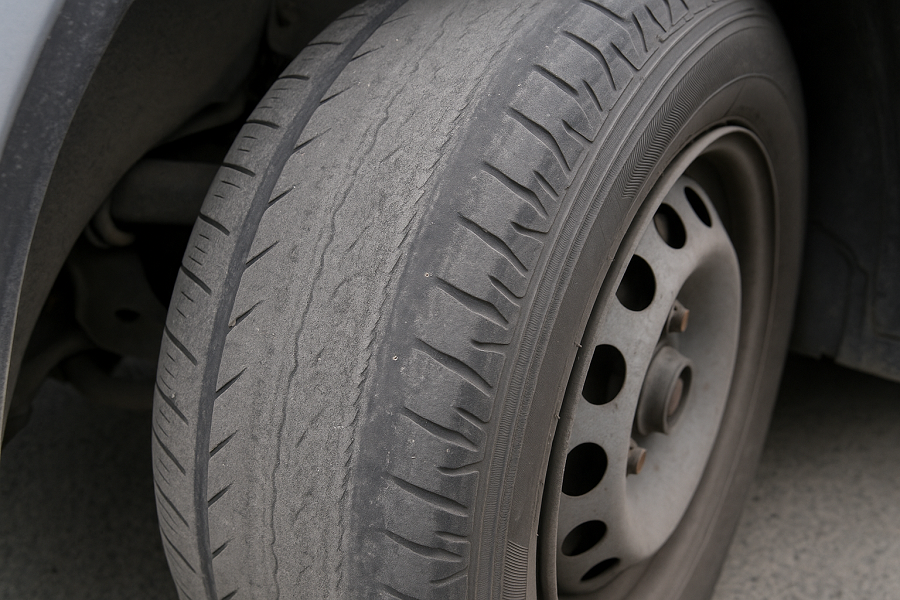
Effective Diagnosis Steps
Diagnosing Wear on Inside of Tyre involves a mix of visual checks, driving tests, and professional tools. Here’s a step-by-step approach:
- Visual Tire Inspection:
- Check tread depth across the tire (inner, middle, outer) with a gauge.
- Look for feathering, scalloping, or bald spots on the inner edge.
- Inspect sidewalls for rubbing marks or cuts.
- Driving Test:
- Drive on a flat, straight road and note if the car pulls to one side.
- Listen for tire noise or vibrations, especially during turns.
- Test braking and cornering to feel for reduced grip.
- Suspension Check:
- With the car safely jacked up, wiggle each wheel to check for looseness (indicating worn bushings or ball joints).
- Inspect shocks and struts for leaks or damage.
- Alignment Check:
- Visit a mechanic with an alignment rack for precise measurements of camber, toe, and caster (another alignment angle affecting steering).
- Ask for a printout of the alignment specs to compare against your car’s factory settings.
- Tire Pressure Verification:
- Use a reliable tire pressure gauge to check all four tires against the recommended PSI.
- Adjust pressure when tires are cold (before driving).
If you’re not comfortable with these steps, a trusted mechanic or tire shop can perform a full diagnosis, often for $50–$100.
How to Fix Inner Tire Wear
Fixing Wear on Inside of Tyre depends on the root cause, but here are both DIY and professional solutions to get your tires back in shape.
DIY Fixes
- Check and Adjust Tire Pressure: Use a gauge to ensure all tires are at the manufacturer’s recommended pressure. Do this monthly to prevent uneven wear.
- Tire Rotation: Rotating tires (e.g., front to back) every 6,000–8,000 miles can even out wear, especially if the issue is mild. Follow your car’s rotation pattern (check the owner’s manual).
- Visual Suspension Check: Look for obvious damage, like leaking shocks or torn rubber bushings. While you can’t fix these at home, identifying them can save diagnostic time at the shop.
Professional Fixes
- Wheel Alignment: A professional alignment (costing $75–$150) adjusts camber, toe, and caster to factory specs. This is the most common fix for Rear tires wearing on inside of Tyre caused by misalignment.
- Suspension Repairs: Worn parts like control arms, bushings, or ball joints may need replacement. Costs vary widely ($200–$1,000+), depending on the part and labor.
- Tire Replacement: If the inner tread is worn below 2/32 inches, replace the tire. Always replace tires in pairs (both front or both rear) to maintain balance.
- Balancing: Unbalanced tires can exacerbate wear. A shop can balance tires for $10–$20 per wheel.
When to Act
If the wear is mild (tread depth above 4/32 inches), an alignment and tire rotation might suffice. For severe wear or damaged suspension, consult a mechanic immediately to avoid safety risks.
Preventive Maintenance Tips
Preventing inner tire wear is easier than fixing it. Here are practical tips to keep your tires wearing evenly:
- Regular Alignment Checks: Get an alignment every 12,000 miles or after hitting a major pothole or curb. This keeps camber and toe in check.
- Monitor Tire Pressure: Check pressure monthly and before long trips. Use a digital gauge for accuracy.
- Rotate Tires: Follow your car’s recommended rotation schedule to distribute wear evenly.
- Inspect Suspension: Have a mechanic check your suspension during routine maintenance (e.g., oil changes) to catch wear early.
- Drive Smoothly: Avoid aggressive cornering, rapid acceleration, or braking, which stress tires and suspension.
- Choose Quality Tires: Invest in tires suited to your vehicle and driving conditions. Cheap tires may wear faster or unevenly.
Example Maintenance Schedule
- Monthly: Check tire pressure and visually inspect tread.
- Every 6,000–8,000 miles: Rotate tires and check alignment.
- Annually: Professional suspension and alignment inspection.
Conclusion
Wear on the inside of your tire is more than an annoyance; it’s a clue that your car needs care. Whether it’s a misaligned wheel, a worn suspension part, or incorrect tire pressure, handling the problem early can save you from expensive repairs and keep you secure on the road. By recognizing symptoms like pulling, vibrations, or uneven tread, analyzing the cause with simple checks, and following through with fixes like alignment or tire rotation, you can extend your tires’ life and enhance your vehicle’s performance.
